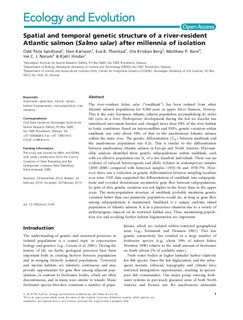| dc.contributor.author | Sandlund, Odd Terje | |
| dc.contributor.author | Karlsson, Sten | |
| dc.contributor.author | Thorstad, Eva Bonsak | |
| dc.contributor.author | Berg, Ole Kristian | |
| dc.contributor.author | Kent, Matthew Peter | |
| dc.contributor.author | Norum, Ine Cecilie Jordalen | |
| dc.contributor.author | Hindar, Kjetil | |
| dc.date.accessioned | 2017-10-20T11:20:18Z | |
| dc.date.available | 2017-10-20T11:20:18Z | |
| dc.date.created | 2014-04-08T12:56:26Z | |
| dc.date.issued | 2014 | |
| dc.identifier.citation | Ecology and Evolution. 2014, 4 (9), 1538-1554. | nb_NO |
| dc.identifier.issn | 2045-7758 | |
| dc.identifier.uri | http://hdl.handle.net/11250/2461263 | |
| dc.description.abstract | The river-resident Salmo salar (“småblank”) has been isolated from other Atlantic salmon populations for 9,500 years in upper River Namsen, Norway. This is the only European Atlantic salmon population accomplishing its entire life cycle in a river. Hydropower development during the last six decades has introduced movement barriers and changed more than 50% of the river habitat to lentic conditions. Based on microsatellites and SNPs, genetic variation within småblank was only about 50% of that in the anadromous Atlantic salmon within the same river. The genetic differentiation (FST) between småblank and the anadromous population was 0.24. This is similar to the differentiation between anadromous Atlantic salmon in Europe and North America. Microsatellite analyses identified three genetic subpopulations within småblank, each with an effective population size Ne of a few hundred individuals. There was no evidence of reduced heterozygosity and allelic richness in contemporary samples (2005–2008) compared with historical samples (1955–56 and 1978–79). However, there was a reduction in genetic differentiation between sampling localities over time. SNP data supported the differentiation of småblank into subpopulations and revealed downstream asymmetric gene flow between subpopulations. In spite of this, genetic variation was not higher in the lower than in the upper areas. The meta-population structure of småblank probably maintains genetic variation better than one panmictic population would do, as long as gene flow among subpopulations is maintained. Småblank is a unique endemic island population of Atlantic salmon. It is in a precarious situation due to a variety of anthropogenic impacts on its restricted habitat area. Thus, maintaining population size and avoiding further habitat fragmentation are important. | nb_NO |
| dc.language.iso | eng | nb_NO |
| dc.publisher | Wiley Open Access | nb_NO |
| dc.rights | Navngivelse 4.0 Internasjonal | * |
| dc.rights.uri | http://creativecommons.org/licenses/by/4.0/deed.no | * |
| dc.title | Spatial and temporal genetic structure of a river-resident Atlantic salmon (Salmo salar) after millennia of isolation | nb_NO |
| dc.type | Journal article | nb_NO |
| dc.type | Peer reviewed | nb_NO |
| dc.description.version | publishedVersion | nb_NO |
| dc.source.pagenumber | 1538-1554 | nb_NO |
| dc.source.volume | 4 | nb_NO |
| dc.source.journal | Ecology and Evolution | nb_NO |
| dc.source.issue | 9 | nb_NO |
| dc.identifier.doi | 10.1002/ece3.1040 | |
| dc.identifier.cristin | 1127733 | |
| dc.description.localcode | © 2014 The Authors. Ecology and Evolution published by John Wiley & Sons Ltd. This is an open access article under the terms of the Creative Commons Attribution License (CC BY 3.0) (https://creativecommons.org/licenses/by/3.0/) | nb_NO |
| cristin.unitcode | 194,66,10,0 | |
| cristin.unitname | Institutt for biologi | |
| cristin.ispublished | true | |
| cristin.fulltext | original | |
| cristin.qualitycode | 1 | |

